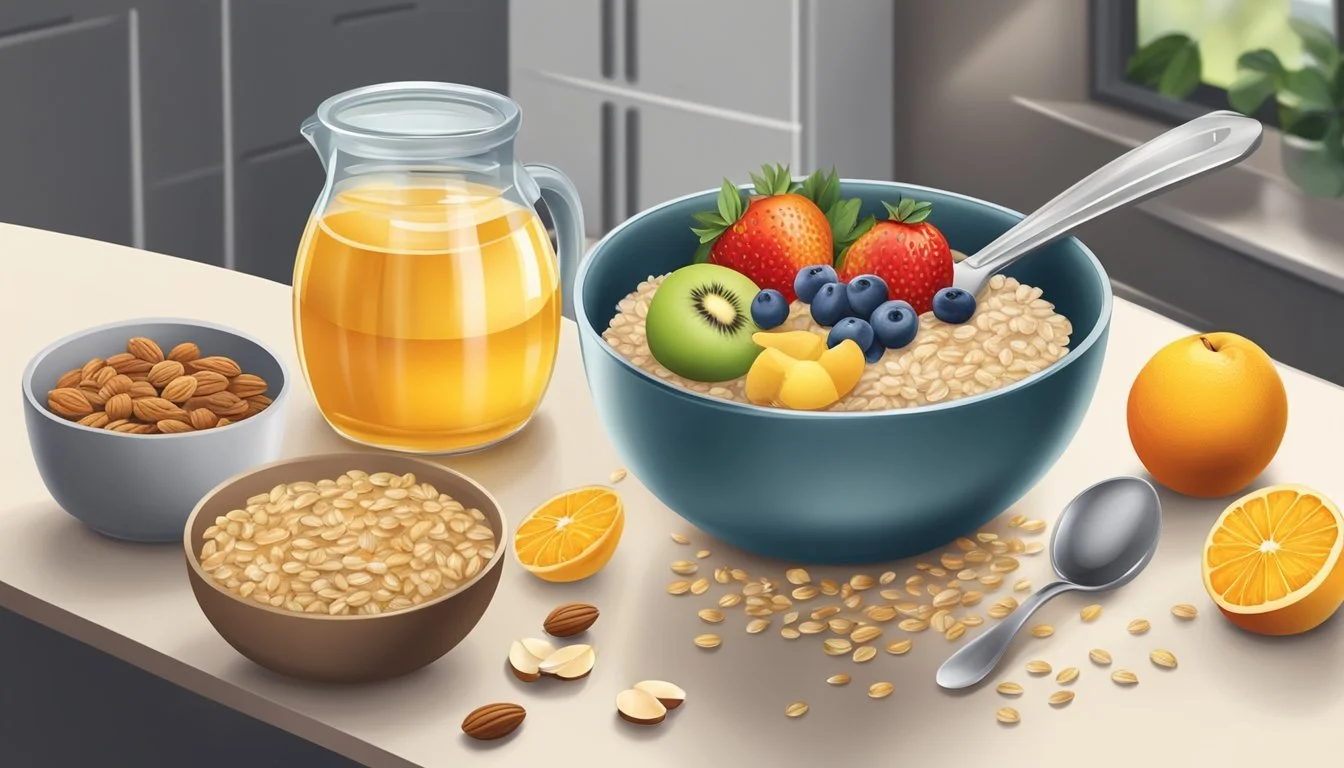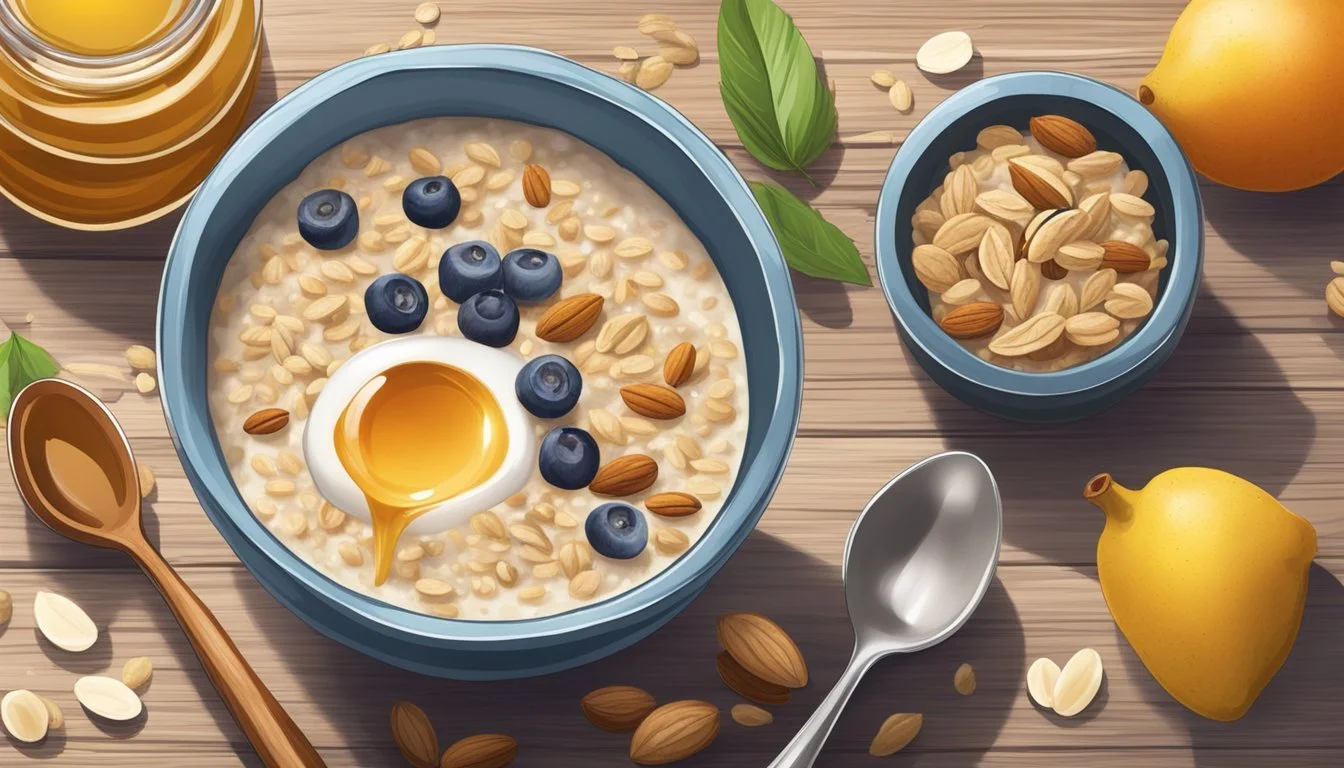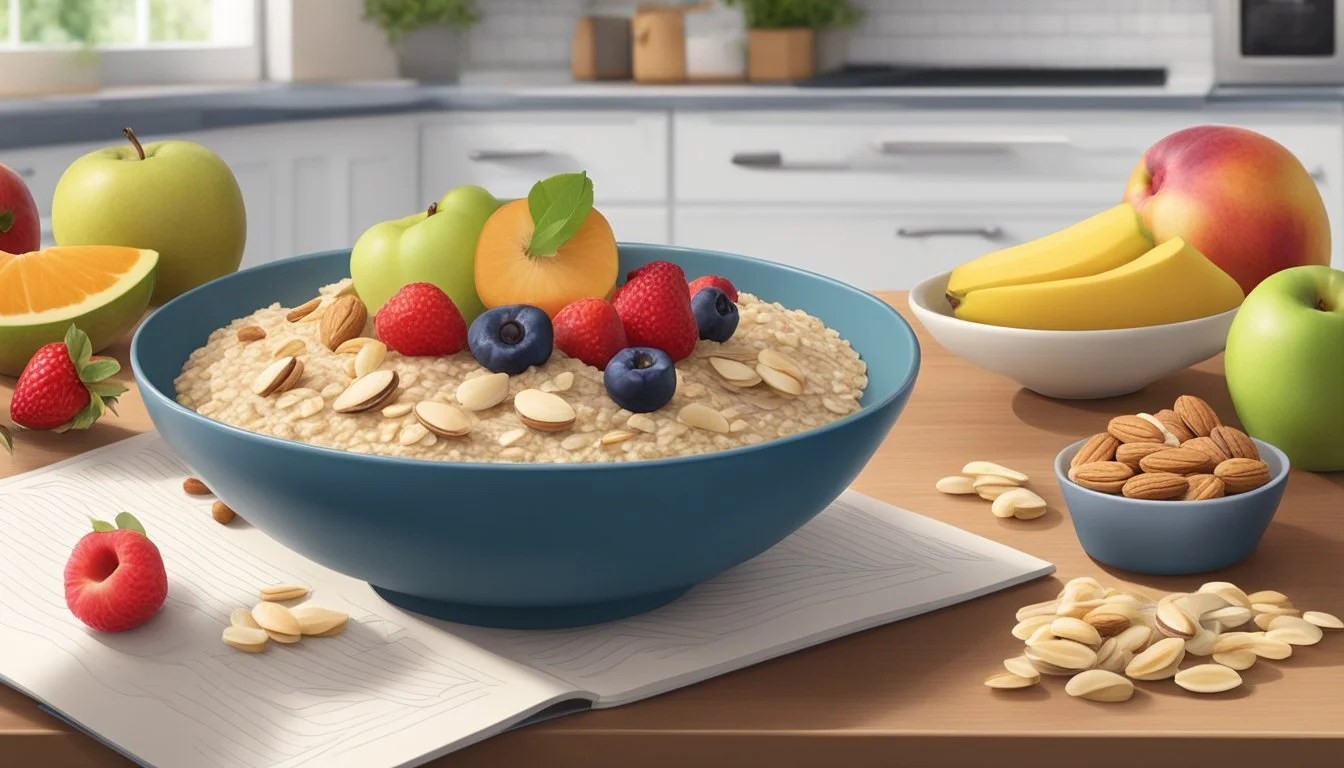How to Cook with Quaker Oats for Healthy Options
Simple & Nutritious Recipes
Quaker Oats have been a staple in pantries around the world for their versatility and health benefits. Rich in fiber and nutrients, oats are an excellent choice for those looking to include more whole grains in their diet. The soluble fiber found in oats, particularly beta-glucan, is known to help reduce cholesterol levels and can aid in blood sugar management, making it a strategic food for heart health and for those with diabetes.
Cooking with Quaker Oats offers a multitude of healthy options that cater to both taste and nutrition. Whether it's starting the day with a hearty bowl of oatmeal or experimenting with oats as a binder in meatloaf or as a crumble topping for desserts, oats provide a nutritious base for various recipes. Given their neutral taste profile, oats easily absorb the flavors they are paired with, enhancing meals not just with texture but also with additional health benefits without compromising on taste.
The nutritional profile of Quaker Oats is impressive, as they are a good source of important vitamins and minerals such as magnesium, iron, and zinc. This makes them an ideal ingredient for those conscious about maintaining a balanced diet. Using oats as a key ingredient allows for creativity in the kitchen, offering ways to improve the nutritional quality of everyday meals while enjoying the comforting familiarity of this whole grain.
Selecting Your Oats
When opting for Quaker Oats in a diet, understanding the variety and nutritional content is key to making health-conscious choices.
Understanding Oat Types
Quaker Oats offers a range of oat products suitable for different cooking needs and preferences. Steel-cut oats are whole oat groats cut into pieces and offer a chewier texture, taking longer to cook. Rolled oats, also known as old-fashioned oats, are groat flakes steamed and flattened, balancing cooking time and texture. They remain a versatile option for both cooking and baking. Instant oats are pre-cooked, dried, and then rolled and pressed thinner than rolled oats, allowing them to cook more rapidly and offer convenience.
Oat Type Texture Cooking Time Steel-cut oats Chewy 20-30 min Rolled oats Moderate 10-15 min Instant oats Softest 1-5 min
Nutritional Benefits of Oats
Oats, in general, are a powerhouse of nutritional benefits. They are a good source of fiber, particularly beta-glucan, known for its abilities to lower cholesterol and potentially regulate blood sugar levels. Oats are also rich in protein, essential for muscle repair and growth. Moreover, Quaker Oats provide important minerals such as iron, which is vital for blood health; magnesium, which supports muscle and nerve function; and zinc, important for the immune system. The inclusivity of oats in meals contributes to a balanced diet.
Nutrient Benefit Fiber Lowers cholesterol Protein Aids in muscle repair Iron Crucial for creating red blood cells Magnesium Supports muscle/nerve function Zinc Strengthens immune system
Preparation Basics
When cooking with Quaker Oats, the key factors to consider are the choice of liquid, cooking method, and the ratio of oats to liquid to achieve the perfect consistency and flavor.
Choosing the Right Liquid
One can opt for water or milk as the liquid base for cooking oats. Water is the classic choice for a simpler flavor, while milk adds creaminess and richness. For healthier options, one might consider using nonfat or low-fat milk. A pinch of salt can be added to enhance the oats' natural flavor, especially when cooking with water.
Cooking Methods
The two primary methods for preparing Quaker Oats are the microwave method and the stovetop method. For the microwave method, one should combine oats with liquid in a microwave-safe bowl and cook on high, stirring periodically, until the oats reach the desired consistency. For the stovetop method, one brings the liquid to a boil in a saucepan, adds the oats, reduces the heat, and lets them simmer while occasionally stirring.
Oat-to-Liquid Ratios
A basic guideline for oat-to-liquid ratios is 1 part oats to 2 parts liquid. Specifically, for cooking:
1/2 cup of oats, use 1 cup of water or milk.
1 cup of oats, use 2 cups of water or milk.
Following these ratios ensures the oats will cook properly, absorbing the liquid to become tender yet not too soggy. Adjustments can be made depending on desired thickness.
Building Flavor and Texture
Quaker Oats offer a versatile canvas for a range of flavors and textures, from the creamy consistency to the lush aromas that satisfy both sweet and savory cravings.
Sweet and Savory Variations
When one mentions oatmeal, a classic sweet variant generally comes to mind. Sweetening oatmeal typically involves ingredients like brown sugar or honey for a natural touch of sweetness. For a richer taste, maple syrup serves as a hearty addition, imbuing a distinct, caramel-like flavor. Cinnamon can be sprinkled for a spicy warmth, and a pinch of salt is key in balancing the sweetness and enhancing the overall flavor profile.
For those with savory leanings, Quaker Oats need not be pigeonholed into only sweet applications. They can be prepared with aromatic spices, or combined with a sprinkle of salt and a drizzle of olive oil. For a savory breakfast bowl, incorporate poached eggs and a scattering of fresh herbs.
Creative Mix-ins
To enhance texture and add complexity to your oatmeal, consider the following Mix-ins:
Crunch: Add nuts like almonds or walnuts for a satisfying crunch.
Chewiness: Mix in dried fruits (What wine goes well with dried fruits?) such as raisins or cranberries.
Creaminess: Stir in a dollop of yogurt or a splash of milk.
Freshness: Fresh fruits can introduce a juicy, refreshing element.
Spice: Beyond cinnamon, consider nutmeg or ginger for a warm and cozy touch.
Experiment with vanilla extract to add depth or a combination of sweet and savory elements for a complex palate experience. The key is to think about contrasting textures that complement the natural smoothness of cooked oats.
Healthy Oatmeal Enhancements
Enhancing oatmeal can transform it from a simple breakfast option to a nutrient-rich power meal. The incorporation of fruits, nuts, and superfood boosters increases both the flavor and nutritional value.
Fruit and Nuts Additions
When one adds fruits and nuts to their oatmeal, they are not only enriching the taste but also fortifying their meal with essential vitamins, minerals, and healthy fats.
Fresh Fruit: Fresh fruits like blueberries and slices of banana introduce antioxidants and natural sweetness.
Blueberries: High in vitamins C and K.
Bananas: A good source of potassium and dietary fiber.
Dried Fruits: Dates and dried cherries offer concentrated flavors and an energy boost.
Dates: Rich in fiber, which aids digestion.
Dried Cherries: Contain anti-inflammatory properties.
Nuts: Adding a handful of almonds or a sprinkle of chopped walnuts provides a satisfying crunch and a dose of healthy fats.
Almonds: Excellent source of vitamin E and magnesium.
Walnuts: Contain alpha-linolenic acid, an omega-3 fatty acid.
Superfood Boosters
Incorporating superfoods into oatmeal can significantly uplift its health quotient with minimal effort.
Seeds: Chia seeds and flaxseeds are small additions that make a big impact on the nutritional front.
Chia Seeds: Deliver a substantial amount of fiber and omega-3 fatty acids.
Flaxseeds: Known to improve digestive health and lower blood pressure.
Nut Butters: Stirring in a tablespoon of almond butter or peanut butter contributes to creaminess and adds heart-healthy fats.
Almond Butter: A great source of monounsaturated fats and protein.
Peanut Butter: No-sugar-added versions enhance flavor without extra sugar.
Coconut: Shredded coconut or coconut flakes may be sprinkled on top for their fiber content and unique tropical taste.
Coconut: Provides medium-chain triglycerides known for their energy-boosting properties.
In summary, incorporating fruits, nuts, and superfood boosters not only enriches the taste profile of oatmeal but also enhances its nutritional value, contributing to a healthier and more satisfying meal.
Oatmeal for Every Meal
Quaker Oats can transform into a nutritious and delicious meal for any time of the day. From a morning kick-starter to a comforting evening dessert, they provide a versatile base for countless recipes.
Breakfast Favorites
Overnight Oats: The night before, combine Quaker Oats with milk or a milk alternative, a spoonful of yogurt, and your choice of toppings such as fruit or nuts. Let it sit in the refrigerator overnight, and by morning, one has a creamy, flavorful breakfast waiting for them.
Baked Oatmeal: For a warm breakfast, mix oats with your preferred milk, an egg for binding, and add-ins like chocolate chips or blueberries. Bake until set and slightly golden. This provides a heartier texture than stovetop oatmeal and is perfect for meal prep.
Lunches and Dinners
Savory Oat Bowls: Quaker Oats aren't just for sweet dishes; they make an excellent base for savory meal options. Cook the oats in broth until creamy, then top with sautéed vegetables, a sprinkle of shredded cheese, and a protein of choice such as grilled chicken or tofu.
Oat-Enhanced Dishes: Quaker Oats can be used to add texture and nutrition to meatloaves or as a base for fritters. They absorb flavors well and can contribute to a more satisfying meal with added fiber.
Snacks and Desserts
Protein-Packed Snack Bars: Combine Quaker Oats with peanut butter and honey, press into a pan, and chill. Cut into bars for a convenient, energy-boosting snack that's easy to take on the go.
Oatmeal Cookies: Oats can be the foundation for a healthier dessert. Mix with ingredients like whole wheat flour, raisins, and chocolate chips to create a treat that's indulgent yet still offers the nutritional benefits of whole grains.
Understanding Health Implications
Cooking with Quaker Oats provides a variety of health benefits ranging from weight management to improved heart health. These oats are a wholesome choice, rich in fiber and low in calories, contributing to a balanced diet.
Weight Management
Quaker Oats are low in calories, which makes them an excellent food choice for weight management. They are high in soluble fiber, which can help one feel fuller longer, thus reducing the overall calorie intake. Incorporating oats into one's diet can assist in maintaining a healthy weight.
Heart Health
Oats are a heart-healthy food due to their whole grain content and the presence of beta-glucan, a type of soluble fiber known to help lower cholesterol levels. Regular consumption of oats as part of a diet low in saturated fat and cholesterol may reduce the risk of heart disease. Quaker Oats contain fiber and other essential nutrients that support heart health.
Blood Sugar Control
Quaker Oats have a low glycemic index, meaning they have a more gradual effect on blood sugar levels. This makes them a beneficial food for people managing diabetes or trying to stabilize their blood sugar. The bran and fiber in oats slow the absorption of carbohydrates into the bloodstream, contributing to better blood sugar control.
Personalizing Your Oat Experience
Quaker Oats offer a versatile foundation for a myriad of healthy and personalized meals, allowing individuals to cater to convenience preferences, dietary needs, and health objectives.
Quick and Convenient Options
For those with a tight schedule, instant oats offer a quick and convenient breakfast option. They can easily be prepared in the microwave; just combine the oats with a ratio of water or milk and heat for about 1-2 minutes. Here is a simple guide:
Texture Preference: For a creamy texture, stir halfway through cooking.
Flavor Variations: To make them more customizable, add fruit, nuts, or a dollop of yogurt.
Nutritional Boost: Sprinkle in some chia seeds or flaxseed for extra fiber and protein.
Tailoring to Dietary Needs
Quaker Oats are inherently adaptable, making them suitable for various nutritional requirements.
Heart Health: Maintain a diet supportive of heart health by opting for oats in place of refined grains, complementing them with fruits and vegetables.
Weight Management: Employ oats as part of a caloric-controlled diet, leveraging their high fiber content to promote satiety.
Gluten Sensitivity: Select certified gluten-free oats to ensure the diet remains aligned with gluten intolerance constraints.
Protein Enrichment: For those seeking additional protein, stir in nut butters or protein powder after cooking to enhance the meal's protein quota.
In each case, it's important for the individual to consult the nutrition information for proper portion sizes and to inform their dietary choices in alignment with personal health goals and requirements.
Oats Beyond the Bowl
While oats are commonly associated with breakfast cereals and porridge, their use in the kitchen extends far beyond the traditional bowl of oatmeal. Their versatility allows them to transform into both sweet and savory dishes, offering nutritious and heart-healthy benefits across various recipes.
Incorporating Oats into Recipes
Oats lend their texture and nutritional value to a wide range of recipes. They can be an integral ingredient in energy bars or a hearty addition to smoothies, contributing fiber and substance. Rolled oats are particularly well-suited for incorporating into baked goods, like muffins and cookies, adding chewiness and moisture retention.
Example uses of rolled oats in recipes include:
Energy Bars: Mix rolled oats with nuts, seeds, dried fruits, and a binding agent like honey or peanut butter.
Smoothies: Add rolled oats to thicken the texture and boost the nutritional content.
For a savory twist, one can use oats to create a textured topping for casseroles or as a healthier breading alternative for chicken or fish. Steel-cut oats work well in savory dishes due to their chewier and more substantial texture, which holds up well in recipes like stuffed peppers or meatloaves.
Utilizing Oats in Alternative Forms
Oats can be milled or ground to produce oat flour, which provides a gluten-free alternative to wheat flours for those with dietary restrictions or preferences. Oat flour can be used entirely or partially in place of regular flour in pancakes, waffles, and other baked items, adding a mildly nutty flavor and dense texture.
Ways to use oat flour:
Baking: Substitute up to 1/3 of regular flour with oat flour in recipes for a healthful twist.
Mix-ins can also change the flavor profile and textures of oat-based recipes. Items such as fresh fruits, nuts, spices, or even chocolate chips can transform simple oat dishes into personalized treats.
In summary, oats can be easily introduced into a wide array of recipes and serve as a nutritious foundation for multiple types of dishes. Whether it's through rolled oats in baked goods, steel-cut oats in savory dishes, or oat flour in gluten-free baking, the options are plentiful.
Connecting with Quaker Oats
Quaker Oats offers consumers various ways to stay informed and engage with its community. These avenues allow individuals to stay current on product updates, participate in sweepstakes, and connect with health professionals for nutritious guidance.
Staying Updated
Consumers looking to remain abreast of the latest from Quaker Oats can subscribe to the Quaker Oats Center of Excellence newsletter. This service delivers updates directly to one’s email, encompassing topics like new product announcements, health tips, and exclusive offers. PepsiCo Tasty Rewards is a platform where individuals can find additional offers by signing up for alerts and updates, including:
New Product Releases: Be the first to try new Quaker Oats products.
Health Advice: Receive tips from nutrition experts.
Special Promotions: Access savings and coupons.
Engaging with the Community
Engagement with the Quaker Oats community offers chances for consumers to participate in sweepstakes and contests, fostering a deeper connection. This comes with a clear set of terms that ensure fair participation. Here’s how one can interact:
Join Sweepstakes: Opportunities for prizes and special offers.
Connect with Health Professionals: Quaker Oats provides access to health and nutrition experts for those seeking professional advice on incorporating oats into a healthy lifestyle.
By taking advantage of such opportunities, consumers can enhance their experience with Quaker Oats.
Preparing Oats for Various Preferences
Quaker Oats offer versatility that caters to different tastes and dietary needs, allowing one to adjust for creamier texture and enhance flavor to match personal or cultural preferences.
Adjusting Consistency and Flavor
For those seeking a creamier texture, using milk instead of water when cooking oats is an effective method. The ratio of liquid to oats significantly influences consistency; a 2:1 liquid-to-oat ratio typically yields a softer consistency. To further customize oatmeal to individual taste, the cook time can be altered. Less time will result in firmer oats, while more time allows for softer, creamier oats.
Flavorful oatmeal is achievable by adding spices, sweeteners, or fruit. Cinnamon, vanilla extract, or a pinch of salt can enhance the oatmeal's flavor profile. Honey, maple syrup, or brown sugar serves as sweet additions, while the inclusion of fresh or dried fruits can provide natural sweetness and texture.
Exploring Cultural Oat Dishes
Oats are not limited to sweet breakfast dishes; cultural recipes often incorporate oats into savory meals. Adapting Quaker Oats to suit cultural preferences can involve the addition of different spices, herbs, and ingredients relevant to regional cuisines. For instance, savory oatmeal might include soy sauce and scallions for an Asian-inspired dish, or olive oil and rosemary for a Mediterranean twist.
To experiment with savory options, oats can be used in place of rice or other grains in pilafs or stir-fry dishes. This not only introduces variety to the diet but can also integrate oats into lunch and dinner meals, providing a different take on this versatile grain.
Conclusion
Quaker Oats have long stood as a breakfast staple for those seeking a healthy breakfast option. These oats offer a nutritious foundation, rich in fiber and essential micronutrients, making them an ideal start to the day. Quaker Oats' versatility extends beyond merely being a warming bowl of oatmeal; they can serve as an ingredient in many recipes, from smoothies to baked goods.
Not only are they convenient due to their quick preparation time, but they also adapt seamlessly to various dietary preferences and restrictions. For individuals with time constraints, this quick preparation ensures that a nutritious meal is always within reach.
To incorporate them as part of a balanced diet, one might cook Quaker Oats simply with water or milk and add a mix of fresh fruits, nuts, or a drizzle of honey for natural sweetness. This simple approach allows for a customizable and satisfying meal.
In terms of health, they provide a whole-grain option that supports heart health and promotes satiety. For those aiming to maintain or improve their well-being, incorporating Quaker Oats into one's diet is a practical choice.
Finally, the sheer variety of options available—from instant to old-fashioned to steel-cut—ensures that there is an oat type to fit any texture preference and cooking need, cementing Quaker Oats as a truly versatile kitchen staple.
Additional Resources
When seeking to expand one's culinary skills and knowledge about healthy cooking with Quaker Oats, a variety of resources are available. These may include advice from health professionals, detailed nutrition information, and brand-focused insights to enhance the cooking experience.
Finding More Information
Health Professionals: For readers aiming to understand the health benefits associated with Quaker Oats, consulting with health professionals such as dietitians or nutritionists can provide personalized advice aligned with individual dietary needs.
Nutrition Information: Quaker Oats packaging and the brand's official website are reliable sources for accurate nutrition facts. They offer specific data on calories, fiber, protein, and other essential nutrients per serving.
Quaker Oats Center of Excellence Newsletter: By subscribing to the Quaker Oats Center of Excellence newsletter, individuals can receive regular updates, recipes, and insights directly from the brand, ensuring they stay informed about the latest in oat-based nutrition and cooking techniques.
Readers are encouraged to explore these resources to gain comprehensive knowledge on integrating Quaker Oats into a healthy diet effectively.









